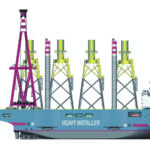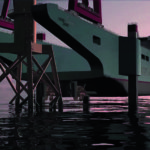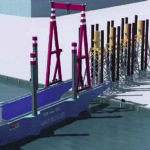The vessel is designed for fast-track serial installation of offshore wind farms. The concept aims to reduce construction work at sea. Only the interface between tower and foundation has to be connected offshore
Offshore wind farm installation work will become one of the most demanding operations for the next decades. A large number[ds_preview] of wind parks is intended to be installed in the North and Baltic Sea, in Europe and indeed all over the world. Up to now, the installation technology and philosophy of recent projects is based on the experiences gathered from the offshore oil and gas industry. However, the available fleet of installation vessels with its oil and gas driven charter rates is not always best suited for the serial production character of the future offshore wind farm installation.
Nordic Yards has worked extensively on several wind installation vessel projects over the last couple of years, thereby obtaining deep insight into the particular boundary conditions and objectives of this field. Nordic Yards now comes up with an own concept that tackles the main challenges in an innovative way. The newly developed »Nordic Heavy Installer« indeed constitutes an original concept for the windmill erection task. At the same time, it embodies a new combination of well-proven single design elements.
Current concepts are stretched to their limits
The major uncertainty of all logistic concepts for offshore wind installation is the downtime due to environmental conditions. Current technologies and most concepts are based on the sequential installation of single components and require calm weather conditions for the assembly process. Another key aspect is the supply of material. In general, two philosophies are predominant: on the one hand the feeder concepts, where an installation vessel, mostly a jack-up rig, is working in the field while supply vessels deliver the single components in a shuttle service. The major problem with this approach is the cargo handling between the jacked up installation rig and the free floating supply vessel. Heave compensation systems for the high loads to be handled in the offshore wind industry are not established yet and seem to be non-realistic for some time to come. As a consequence, those concepts would require – in any case – very calm environmental conditions, leading to an uneconomic installation.
The second principal approach is the combination of an offshore assembly, installation and supply vessel in one unit. It shuttles all single elements between a hub port and the offshore windmill park and performs the whole assembly offshore, which makes it vulnerable in terms of environmental conditions, in particular the (cantilever-type) crane operations in high winds do limit the assembly window. Due to the high required displacement of such units and the integration of a suitable jacking system in combination with requirements of cargo deck layout, the underwater geometry of those vessels can only be a compromise, leading to an excessive hull resistance and high operational costs.
Minimising offshore construction and downtimes
The new philosophy behind the »Nordic Heavy Installer« is to reduce the amount of offshore construction work to a minimum and to shift most of it to onshore facilities. Therefore the tower, nacelle, hub and blades are assembled and pre-tested in harbour in whole. Only the interface between tower and foundation has to be connected offshore. Furthermore the vessel’s intention is to cover the complete logistic chain: starting from efficient foundation installation for pre- and post-piling structures up to the final assembly of the wind turbine.
The hull is designed for best sea keeping behaviour and low resistance. A twin shaft line FPP propulsion in combination with high efficient rudders and transverse tunnel thrusters enables the vessel to sail in harsh conditions with the most unfavourable loading case as well as to fulfil the requirements of dynamic positioning operation. The jack-up system with its spud cans is arranged above the water line to eliminate the increase of resistance in transit. Cargo handling is realised by an integrated gantry crane running on the vessel’s sides.
For loading in harbour, the vessel’s stern with its enlarged box girders is positioned above quay. Depending on tidal influences it might be either semi- or fully jacked. In static jacked conditions the gantry crane, running on the vessel’s sides, will load the vessel. During transit, cargo and gantry crane are sea fastened.
In the wind field, the »Nordic Heavy Installer« is dynamically positioned at the dedicated installation point. The gantry crane is able to compensate deviations in the ship’s longitudinal and transverse axis of more than five meters, so the operation time in DP mode can be reduced, and after preloading, the vessel jacks quickly out of the water. Special attention was paid to increase the independence from environmental conditions also for the crane operations, so tugger winches were integrated to give an additional horizontal guidance for safe handling of large components. Furthermore, two auxiliary cranes are implemented for pile ramming while the 1,300 t main hook is supporting the foundation.
After installation of either foundation structure or wind turbine, the Nordic Yards »Heavy Installer« is lowered back to floating condition while the two shaft lines give pre-tension on the DP system, enabling the vessel to depart even in worst conditions properly and safely from the installation point.
Jack-up system operates in water depths up to 55 m
Capacity of the vessel is up to four foundations simultaneously. The cargo hold is designed to carry even large jackets and tripods for water depths of 55 m. In wind turbine load cases the most critical dimensions and weights for turbines of the main manufacturers were considered as design basis. Considering a typical 5 MW turbine with 130 m rotor diameter and a gondola weight of 500 t, the »Nordic Heavy Installer« is able to carry four units.
With the help of intensive research and application of enhanced numerical calculation methods, the sea keeping behaviour of the vessel has been optimised to fulfil the strict requirements of wind turbine manufacturers with special respect to the max. accelerations acting on the single components.
Apart from the relatively young offshore wind industry, the design also addresses alternative deployments in demanding conventional heavy lift operations, such as taking on floating cargoes in dockship mode or heavy RoRo operations respectively arbitrary heavy lift LoLo duties.
The main focus, however, is set on offshore wind projects, where economical studies showed significant cost savings for each installed wind turbine compared to the so far known concepts.
Authors: Andre Bergmann, Project Engineer; Stefan Hadeler, Senior Project Engineer; Christian Hinrichs, Senior Project Engineer; Guido Schulte, Head of Project Design Dept.
Contact: heavyinstaller@nordicyards.com
Andre Bergmann, Stefan Hadeler, Christian Hinrichs, Guido Schulte





















